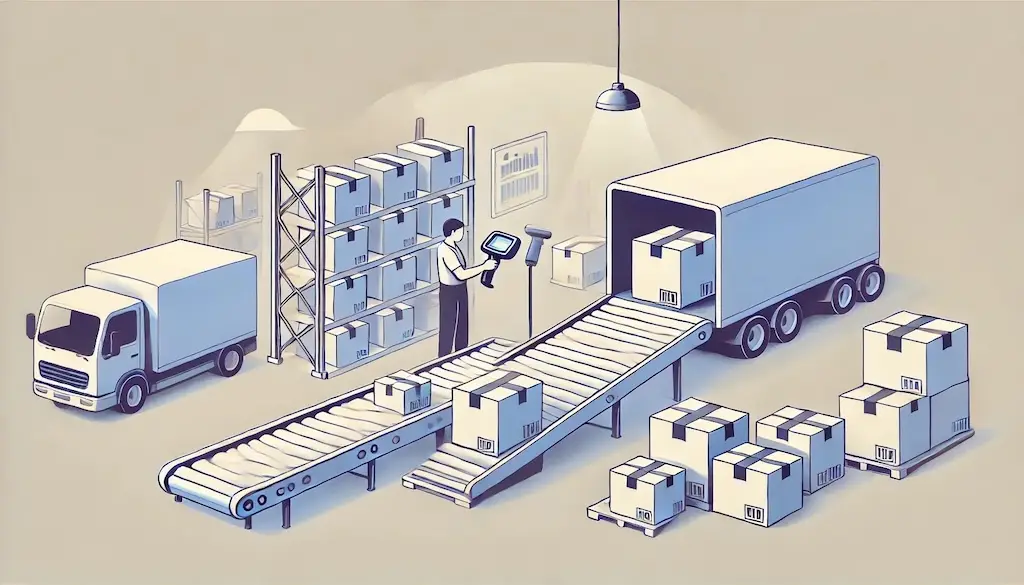Streamlining your receiving inventory process is pivotal for maintaining accurate stock levels and optimizing warehouse efficiency. This article provides you with straightforward guidance on receiving inventory—from checking deliveries against purchase orders to storing goods correctly. You will learn actionable strategies to prevent stockouts, overstocking, and the misplacement of items, ensuring that inventory management becomes a streamlined component of your operations.
Key Takeaways
- An efficient inventory receiving process is critical for warehouse operations, affecting stock levels and supply chain management by optimizing inventory control, order picking, packing, and shipping.
- The receiving inventory process should include accurate documentation, thorough inspection and verification of goods, and precise counting and organized storage, all of which contribute to operational efficiency and customer satisfaction.
- To optimize the inventory receiving process, implement best practices such as Warehouse Management Systems (WMS), regular staff training, and Standard Operating Procedures (SOPs), while addressing common issues like damaged goods, inventory discrepancies, and time management.
The Importance of an Efficient Receiving Inventory Process
The inventory receiving process is the gateway to your warehouse, dictating the flow of products into your storage and affecting every subsequent warehouse operation. An efficient receiving process ensures:
- Accurate stock levels, preventing both stockouts and overstocking
- Availability of popular items for your customers
- Expedited shipping
- Reduced likelihood of product returns
Streamlining your receiving procedures can significantly enhance your warehouse operations. Here are some benefits of streamlining your receiving procedures:
- Reduced manual inventory recounts
- Identification of slow-selling or wasteful stock
- Optimization of storage to save on carrying costs
- Minimized risk of product misplacement and losses
- More organized operations, contributing to overall warehouse efficiency.
However, the advantages of a streamlined receiving inventory process extend beyond warehouse confines. It significantly impacts supply chain management, influencing:
- Inventory control
- Order picking
- Packing
- Shipping
Thus, it plays a significant part in the smooth operation of the larger supply chain.
Key Components of an Effective Receiving Inventory Process
Having acknowledged the significance of an efficient receiving process, we now turn our attention to its key components. These form the foundation that turns your receiving process from a mere set of tasks into a well-coordinated operation. These components include Documentation and Communication, Inspection and Verification, and Counting and Storage.
Let’s explore each one in detail:
Documentation and Communication
The initial essential component of a proper warehouse receiving process includes accurate documentation and communication. Maintaining precise documentation, for instance, a Warehouse Receiving Order (WRO), is critical for shipment tracking and guarantees accurate receipt and storage of inventory. This aids in avoiding inventory discrepancies, thereby reducing long-term inventory issues.
Beyond documentation, structured communication plays a vital role in the receiving process. Regular meetings and clear communication channels ensure collaboration and quick resolution of issues, aligning with the goal of efficient handling of goods upon arrival. Furthermore, pre-receiving preparations involving setting receiving requirements and training staff contribute to a smooth and time-efficient receiving process, reducing errors and discrepancies between received goods and purchase orders.
Inspection and Verification
Rigorous inspection and verification form the second part of an effective receiving inventory process. It is vital to prevent defective items from reaching the customer, ensuring quality control and customer satisfaction. This involves cross-checking the inventory received with the purchase order to ensure that the correct products have been delivered.
Additionally, documenting damages clearly with photographs, noting discrepancies on the BOL or POD, and inspecting for unseen damage are vital for accountability and resolving issues promptly. Verifying individual item details and conducting quality and quantity checks are crucial for product authenticity, accuracy of orders, and operational efficiency during putaway. Promptly reporting discrepancies ensures faster resolutions, minimizes operational disruptions, and builds transparency with suppliers.
Counting and Storage
The last part of an effective receiving process involves precise counting and organized storing of inventory items. Ensuring count accuracy during the receiving process is vital to match store inventory with the order request, helping avoid discrepancies that might cause inventory imbalances. Implementing an efficient inventory storage system boosts productivity by minimizing delays and ensuring that goods are stored cost-effectively, properly labeled, and easy to locate for retrieval. An inventory system plays a crucial role in maintaining this efficiency, including tracking inventory to prevent any issues.
The use of Warehouse Management Systems (WMS) provides the following benefits:
- Accurate, real-time inventory levels
- Enhanced visibility
- Avoidance of backorders
- Improved customer satisfaction
Furthermore, proper categorization and segregation of items based on category support warehouse efficiency by ensuring optimal conditions for storage and smoother operation flow.
Best Practices for Optimizing the Receiving Inventory Process
Apart from these key components, there are strategic measures you can implement to further optimize the receiving inventory process. They include:
- Barcode scanning
- Predictive analytics
- Standardization of the Warehouse Receiving Order process
- Regular inventory audits
- Storage optimization
Let’s delve into these best practices:
Implementing Warehouse Management Systems
Warehouse Management Systems (WMS), a type of warehouse management software, are powerful tools that can automate and enhance efficiency within warehouse operations. By streamlining processes such as:
- inventory movement
- order picking
- packing and shipping
- tracking and tracing
a WMS contributes to a reduction in errors and improvement in planning. Furthermore, it provides real-time data, which is crucial in the receiving inventory process.
In addition to current efficiencies, WMS are also designed for continuous improvements. They adapt with innovations and process enhancements to remain effective in the ever-evolving warehouse management landscape.
Regular Training and Skill Development
It is crucial to provide regular training and skill development for warehouse staff, keeping them up-to-date with best practices and preparing them to manage the complexities of the receiving process. Training employees in areas such as:
- inventory planning
- warehouse setup
- receiving processes
- effective stock counting
- digital inventory recording
Accurate stock counts are fundamental in reducing human errors that lead to inventory discrepancies.
Moreover, familiarizing staff with special handling instructions through training is key to ensuring that goods are treated correctly, reducing the likelihood of damage or accidents. Investment in training programs that enhance communication skills, such as active listening and conflict resolution, contributes significantly to more effective and efficient warehouse operations.
Establishing Standard Operating Procedures
Through step-by-step instructions, Standard Operating Procedures (SOPs) promote consistency and efficiency in the receiving process. SOPs are crucial for transferring operational knowledge within an organization, aiding both new and existing employees. A Warehouse Receiving Process Checklist, as a form of SOP, enhances accuracy, safety, and accountability, leading to cost savings.
Such checklists minimize errors and oversights, preventing inventory discrepancies and resource wastage. SOPs foster better communication among warehouse teams, aligning everyone with the expected processes and protocols. They include procedures for verifying the accuracy of deliveries against purchase orders and recording any variances.
Implementing SOPs throughout the receiving process is essential for maintaining the integrity, timeliness, and reliability of warehouse operations.
Addressing Common Challenges in Receiving Inventory
Even with meticulous preparation, you may still encounter challenges in the receiving inventory process. These may include handling damaged goods, managing inventory discrepancies, and improving time management.
Let’s explore these challenges and how to address them:
Damaged Goods
Handling damaged goods upon receipt can be a significant challenge. When damaged goods are received, it is crucial to accept the shipment rather than refusing it to avoid additional complications and costs. Accepting damaged goods allows for accurate documentation of the damage, a critical step in the claims process for compensation.
Moreover, it is important to:
- Safeguard the damaged freight from further harm
- Store it appropriately, as the receiving party has the responsibility to protect the freight
- Document any anomalies during the receiving inventory process
These steps are essential for the foundation of actions such as the claims process and supplier quality issues resolution.
Training receiving staff on special handling instructions for specific shipments can significantly reduce the risk of damage and accidents.
Inventory Discrepancies
Inventory discrepancy refers to situations where the physical count of inventory does not match the recorded inventory levels. Causes can include:
- Receiving errors
- Items being lost or misplaced
- Inaccurate records of returns
- Outdated warehouse technology
- Insufficiently trained employees
To prevent inventory discrepancies, it is imperative to:
- Count each shipment’s inventory and ensure it aligns with the corresponding purchase order.
- Upon identifying a discrepancy, communicate with the supplier to resolve the error.
- Follow established standard operating procedures to reduce future inventory inaccuracies.
Time Management
Time is a precious commodity in warehouse operations. Employing a prioritization method to schedule receiving activities, focusing on the most critical shipments first, can minimize potential bottlenecks. Using scheduling tools to set specific time slots for processing different types of shipments based on volume and urgency ensures a smooth flow.
Assigning specific tasks to individual team members based on their skills and experience can improve the efficiency and speed of the receiving process. Furthermore, implementing time management techniques such as batching similar tasks together and minimizing interruptions can maintain a high level of productivity in receiving activities.
Integrating Technology for Enhanced Inventory Control
In today’s digital era, technology is instrumental in streamlining warehouse operations. Barcode scanning, RF, and RFID technologies facilitate the quick verification and tracking of incoming inventory by allowing easy scanning to add and recall item information. Warehouse Management Systems provide instructions for unpacking, storage, and facilitate subsequent operations, while also enabling additional automation and real-time data for counting accuracy.
However, implementing RFID and related technologies can present challenges such as data management, interference issues, and the cost of RFID tags. Despite these challenges, real-time tracking facilitated by updated inventory management systems and putaway optimization can significantly reduce discrepancies and inefficiencies within the receiving inventory process.
Maintaining Compliance and Safety in Receiving Inventory
It is of utmost importance to maintain compliance and safety in receiving inventory. To reduce the risk of accidents when handling hazardous materials, it is essential to:
- Provide comprehensive safety training
- Enforce safety guidelines
- Train employees on proper handling and storage of hazardous materials
- Ensure employees use personal protective equipment
- Establish emergency response procedures for potential spills or leaks
By following these steps, you can ensure compliance and safety in receiving inventory.
Streamline Your Warehouse Receiving with SphereWMS
In the quest for optimizing warehouse efficiency and inventory management, SphereWMS emerges as a pivotal solution. Our cloud-based Warehouse Management System (WMS) is designed to transform your receiving inventory process, ensuring precision, efficiency, and real-time insights. SphereWMS addresses the critical aspects of warehouse operations, from receiving and putaway to inventory management, with a suite of features tailored to meet the dynamic needs of warehouses and distribution centers.
Key Features of SphereWMS:
- Automated Receiving & Putaway: SphereWMS simplifies the receiving process with advanced data capture technologies, including barcode scanning and RF, minimizing manual data entry and reducing errors. Our system supports serialized receiving, pallet-level handling, and lot control, ensuring precise inventory counts and complete traceability.
- Efficient Inventory Management: Gain 360-degree visibility of your inventory with SphereWMS. Our system allows for detailed tracking by bin locations, lot numbers, pallet/case IDs, and serial numbers, enhancing compliance and control. Features like stock transfers, inventory adjustments, and cycle counts are automated, improving accuracy and operational excellence.
- Integration and Customization: SphereWMS seamlessly integrates with ERP and eCommerce platforms, eliminating information silos and fostering collaborative decision-making. Our customizable workflows and automated alerts ensure that your warehouse operations are aligned with your business goals, enhancing responsiveness and decision-making capabilities.
- Value-Added Services and Compliance: Manage value-added services with precision for accurate billing and profitability. SphereWMS also facilitates the efficient handling of damaged goods and generates accurate Over, Short, and Damaged (OS&D) reports, maintaining supplier accountability and ensuring compliance.
By implementing SphereWMS, warehouses can achieve a streamlined receiving inventory process, enhanced inventory accuracy, and improved overall efficiency. Our solution is designed to adapt to your unique operational needs, allowing you to focus on strategic growth rather than day-to-day challenges.
Conclusion
Optimizing your receiving inventory process is not just about improving efficiency; it’s about transforming your warehouse into a strategic asset. With SphereWMS, you gain the tools and insights needed to master your inventory, streamline operations, and exceed customer expectations. Our cloud-based WMS ensures that you have real-time visibility and control over your warehouse operations, enabling you to make informed decisions and adapt quickly to market changes.
Ready to elevate your warehouse operations? Contact SphereWMS today to schedule a consultation and discover how our Warehouse Management System can revolutionize your receiving inventory process. Let’s unlock the full potential of your warehouse together.
Frequently Asked Questions:
What is receiving inventory?
Receiving inventory is the essential process of verifying and accepting a shipment into a business’s inventory, ensuring accurate stock levels and supply management.
Why is inventory receiving important?
Inventory receiving is important because it lays a strong foundation for profitability, helps meet inventory KPIs, reduces costs, and streamlines the intake process.
How do you receive inventory in a warehouse?
To receive inventory in a warehouse, you need to answer a Warehouse Receiving Order label (WRO) attached to each stock, which contains a barcode that can be scanned and integrated with warehouse management software to ensure you are receiving the right order.
What are the key components of an effective receiving inventory process?
The key components of an effective receiving inventory process are proper documentation and communication, thorough inspection and verification, and accurate counting and storage of items for efficient inventory management.
How can technology enhance inventory control?
Technology can enhance inventory control through barcode scanning, RF, RFID technologies, and Warehouse Management Systems, which facilitate quick verification and tracking of incoming inventory, enable automation, and provide real-time data for counting accuracy. Embracing these technologies can significantly improve inventory management.











